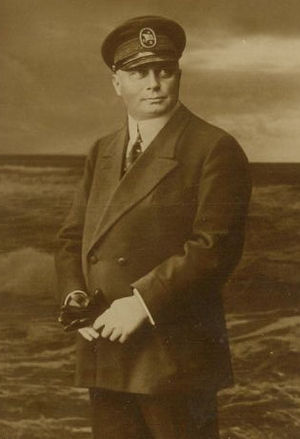German submarine Bremen
 commander of the Bremen, Karl Schwartzkopf | |
| Career (German Empire) | Kaiserliche Marine Ensign |
|---|---|
| Name: | Bremen |
| Builder: | Flensburger Schiffbau |
| Fate: | Disappeared at sea, September 1916 |
| General characteristics | |
| Displacement: | 2,272 tons |
| Length: | 65 m (213 ft) |
| Beam: | 8.9 m (29 ft) |
| Draught: | 5.3 m (17 ft) |
| Propulsion: | 800 hp |
| Speed: |
Surfaced 15 kn (28 km/h; 17 mph) submerged 7 kn (13 km/h; 8.1 mph) |
| Range: | 12,630 mi (20,330 km) |
| Capacity: | 700 tons |
Bremen was a blockade-breaking German merchant submarine of World War I. Developed with private funds and operated by the North German Lloyd Line, she was one of the first of seven U-151 class U-boats built and one of only two used as unarmed cargo submarines.
Construction
Bremen was built together with her sister ship Deutschland in 1916 by the Deutsche Ozean-Reederei, a private shipping company created for the enterprise, a subsidiary company of the North German Lloyd shipping company (now Hapag-Lloyd) and the Deutsche Bank[1]. She was constructed without armaments, with a wide beam to provide space for cargo. The cargo capacity was 700 tons (much of it outside the pressure hull), relatively small compared to surface ships.
Bremen was one of seven submarines designed to carry cargo between the United States and Germany in 1916, through the naval blockade of the Entente Powers. Mainly enforced by Great Britain's Royal Navy, the blockade had led to great difficulties for German companies in acquiring raw materials which could not be found in quantity within the German sphere of influence, and thus substantially hindered the German war effort.
Five of the submarine freighters were converted into long-range cruiser U-boats (U-kreuzers) equipped with two 105mm deck guns, and only two were completed according to the original design: the Deutschland and the Bremen.
First voyage
The Bremen departed Bremerhaven in September 1916 for Norfolk, Virginia, commanded by Kapitaenleutnant Karl Schwartzkopf, and reportedly carrying financial credits for Simon Lake to begin building cargo submarines for Germany. [2]. She did not complete this voyage and her fate is a mystery.
Fate
There are several accounts of Bremen’s demise.
One source records that a submarine believed to have been the Bremen was sighted 300 mi (480 km) south of Iceland on a course for Baltimore and units of the 10th Cruiser Squadron were dispatched to intercept it; HMS Mantua reported ramming a heavy, submerged object. [3]
Another states that Bremen she was sunk by British submarine HMS G13.[4] In March 1917, G13 was on patrol off Shetland, covering the exit by U-boats from the North Sea. There she sighted a submarine identified as Bremen, and fired 2 torpedoes, which both missed. Turning, G13 fired again, first with her starboard beam, and continuing her turn with her port beam torpedoes; both these also missed. Then a final shot, with her stern tube, at a range of 7000 yards, was rewarded with an explosion, and Bremen was believed sunk. However the Admiralty felt this was inconclusive, and withheld credit for the hit. [5]
In the absence of any firm evidence, Bremen was regarded as lost, probably as a result of hitting a mine. [6]
Notes
- ↑ "Primary Documents: German Submarine Deutschland's Atlantic Crossing, 9 July 1916". FirstWorldWar.com. 8 November, 2003. http://www.firstworldwar.com/source/deutschland1.htm.
- ↑ Polmar, Norman; Kenneth J. Moore (2004). Cold War Submarines. Brassey's. pp. 225. ISBN 1574885944.
- ↑ Gibson, R.H.; Maurice Prendergast (2002). The German Submarine War 1914-1918. Periscope Publishing Ltd.. pp. 103. ISBN 1904381081.
- ↑ Gray p 218
- ↑ Grey also records the view that Bremen survived this hit to return to port, where she was written off, and converted into a surface vessel.
- ↑ Akermann, Paul (2002). Encyclopedia of British Submarines 1901-1955. Periscope Publishing Ltd.. pp. 66. ISBN 1904381057.
References
- König, Paul (2001). Voyage of the Deutschland, the First Merchant Submarine. US Naval Institute Press. ISBN 1557504245.
- Edwyn Grey : A Damned Un-English Weapon (1971) ISBN 0 855422 007 0
